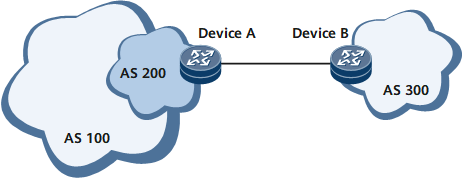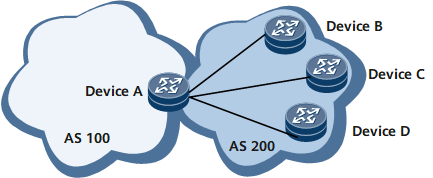Fake AS Number
In the acquisition and merger scenarios between carriers, if the acquiree and the acquirer are located in different ASs, the BGP peers of the acquiree need to be migrated to the AS of the acquirer. However, during network migration, the customer of the acquiree may not want to have local BGP configurations modified right away or at all. As a result, the BGP peer relationships may be interrupted for a long time.
In Figure 1, the AS number of carrier A is 100, whereas the AS number of carrier B is 200. Device A belongs to carrier B. Then carrier A acquires carrier B. In this case, the AS number of device A needs to be changed from 200 to 100. Because device A already has a BGP peer relationship established with device B in AS 300 using AS 200, device A's AS number used to establish the BGP peer relationship needs to be changed to 100. The carrier of AS 100 and the carrier of AS 300 then need to communicate about the change. In addition, the AS number configured on device A and peer AS number configured on device B may not be changed at the same time, which will lead to a lengthy interruption of the BGP peer relationship between the two devices. To ensure a smooth merger, you can run the peer fake-as command on device A to set AS 200 of carrier B as a fake AS number so that device A's AS number used to establish the BGP peer relationship between devices A and B does not need to be changed.
In addition, the AS number of the original BGP speakers of carrier B may be changed to the actual AS number at any time when BGP peer relationships are established with devices of carrier A after the merger. If carrier B has a large number of BGP speakers and some of the speakers use the actual AS number whereas other speakers use the fake AS number during BGP peer relationship establishment with devices of carrier A, the local configuration on BGP speakers of carrier B needs to be changed based on the configuration of the peer AS number, which increases the workload of maintenance. To address this problem, you can run the peer fake-as command with dual-as specified to allow the local end to use the actual or fake AS number to establish a BGP peer relationship with the specified peer.
In Figure 2, the AS number of carrier A is 100, whereas the AS number of carrier B is 200; devices A, B, C, and D belong to carrier B, and device A establishes an IBGP peer relationship with device B, device C, and device D each. Then carrier A acquires carrier B. In this case, the AS number of device A needs to be changed from 200 to 100. Because the AS number used by device A to establish the IBGP peer relationship with devices B, C, and D is 200, the AS number needs to be changed to 100. In this case, carrier A and carrier B need to communicate about the change. In addition, the AS number configured on device A and peer AS number configured on devices B, C, and D may not be changed at the same time, which will lead to a lengthy interruption of the IBGP peer relationships. To ensure a smooth merger, you can run the peer fake-as command on device A to set AS 200 of carrier B as a fake AS number so that device A's AS number used to establish the IBGP peer relationships with devices B, C, and D does not need to be changed.

